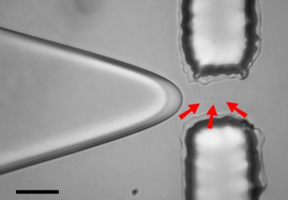Researchers from the US National Institute of Standards and Technology (NIST) have invented a new useful tool for creating chemical reactions between single particles to prepare microdroplets containing single particles of interest

Researchers from the US National Institute of Standards and Technology (NIST) have invented a useful new tool for creating chemical reactions between single particles that can be used for microfluidics - the manipulation of liquids on a microscopic scale - to prepare microdroplets containing single particles of interest.
By combining this state-of-the-art microfluidic method of "a drop as you wish" with "optical collectors" capable of merging several drops and thus causing their chemical content to react with each other, the research may, in the end, lead to the development of a tiny and integrated system for obtaining information at the level The isolated study on the structure and function of important organic substances, such as proteins, enzymes and DNA.
The researchers succeeded in making a microfluidic device with a channel in which water can flow. The water, compressed into a narrow stream as a result of the pressure exerted on it by a mixture of high-viscosity oils, then continues into even narrower enclosures. The sharp drop in water pressure - which also contains a little soapy substance - reduces their surface tension and splits them into tiny pieces, similar to the phenomenon that occurs when a thin stream of water flowing from a faucet splits into drops on its way down.
The size of the fragments is very uniform and adjustable by changing the width of the tubes in the device. Using this method, the researchers were able to create fragments with a diameter of about one micrometer.
In the microfluidic channel, the water shards are loaded with the desired materials, in exactly the right concentration, so that in their final state, each of the shards contains, on average, only one fragment. In each of the fragments, the individual fragments move freely in a kind of spaced sphere, together with water fragments that make up the fragment sheath.
Using a laser beam, the researchers are able to bring two or more fragments closer to each other until they collide and observe the reaction that occurs by optical methods. In their initial experiments, the researchers mixed radiating particles that emit different colors, but in the future they intend to perform more interesting chemical reactions such as the reaction between an antibody and the cause of infection or the reaction between a chromosome and a drug.
The researchers can design a laser beam in any desired shape and therefore it is possible to capture not only individual fragments, but a whole series of them, thus opening a window to new possibilities for microscopy of single particles.
The news from the research institute
A video describing the device's activity
